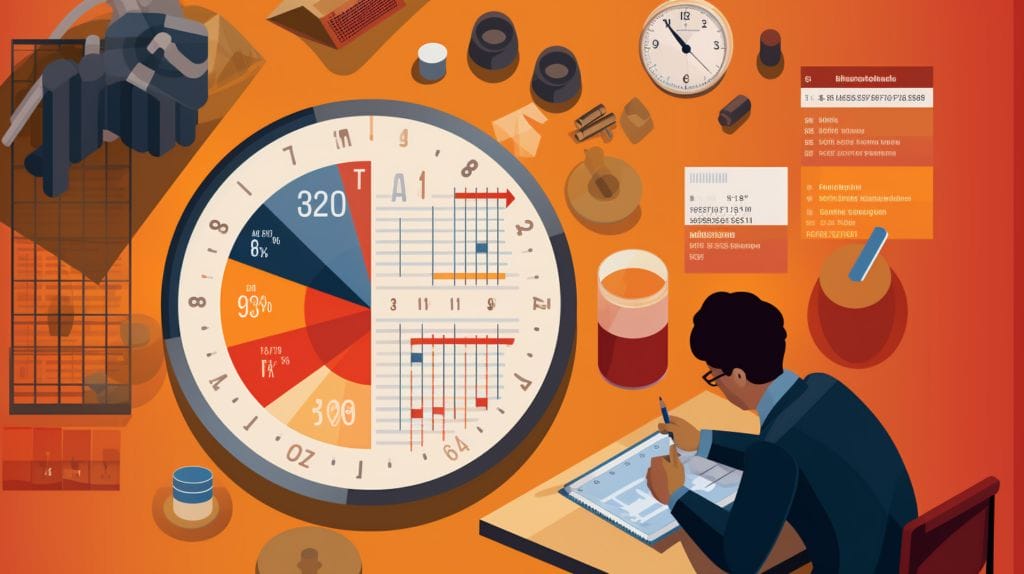Hello everyone! Let’s collectively explore the concept of a work time study. This method is employed to comprehend the mechanisms of work and to identify inefficiencies in certain areas.
I’ll be guiding you through how it’s conducted, interpreting the data, and how to apply these insights to manage your workflow better.
Buckle up as we embark on this journey to master the art of time studies and enhance productivity at your workplace.
Key Takeaways
- They are work measurement tools used to determine the time required for a worker to complete a given task.
- They help improve workflow efficiency by understanding how long tasks take and identifying potential bottlenecks.
- Standard time allows for identifying productivity benchmarks and setting performance goals.
- A representative work sample ensures the accuracy and applicability of time study results.
Unraveling the Concept: What is a Time Study?

Let’s start by understanding what it is and why it’s crucial in the work environment.
It is a systematic observation and measurement of the time it takes for a qualified worker to perform a specific task or series of tasks. It involves breaking down the work into smaller elements and analyzing the time required for each element.
They are used to determine the most inefficient way to complete a task, identify potential bottlenecks or inefficiencies, and establish benchmarks for performance.
Moving on to its role in boosting productivity, allowance is a major concern for most businesses. By conducting these studies, organizations can identify areas where productiveness can be improved.
By analyzing the data collected during time and motion studies, often managed in a spreadsheet, management can identify tasks that are taking longer than necessary and implement strategies to streamline processes and reduce wasted time.
It can also help identify training needs, as it highlights areas where employees may be struggling or taking longer than expected to complete tasks.
Lastly, let’s touch on standard time, a key metric in time studies, and see how it all ties together, ensuring that the sample size is representative.
Standard time refers to the amount of time it should take a skilled worker to complete a task under normal conditions. It is determined based on the data collected and serves as a baseline for measuring productiveness and setting performance goals.
By comparing actual time to standard time, organizations can assess performance and identify areas for improvement. Standard time is often used in conjunction with other metrics, such as rate of working, efficiency, and utilization, to get a comprehensive view of productiveness and performance.
Definition and Purpose of Time Studies
I often hear the term ‘time study,’ but what exactly does it mean, and why is it important in the workplace?
Essentially, they are work measurement tools used to determine the time required for a worker to complete a given task. This method is used to conduct a time study analysis, which can help improve process efficiency.
Here’s what you need to know:
- Time Studies: They’re crucial for understanding how long tasks take and where potential bottlenecks could occur.
- Work Measurement: It’s about quantifying work to manage and improve performance.
- Conduct a Time Study: This process can help identify ineffectiveness and streamline processes.
Mastering it can be a game-changer in optimizing your workplace operations.
The Role of Time Studies in Enhancing Productivity
While it’s true that time and motion studies can seem complex at first glance, once you understand their role in enhancing productivity, you’ll see just how invaluable they can be.
A time study for work is a powerful tool that helps to measure every aspect of a task, from start to finish. It’s not just about clocking hours. It’s about understanding where time is spent and identifying bottlenecks.
Its role is to reveal opportunities for improvement, thereby enhancing productivity. They provide data that can lead to better operational efficiency, as you can streamline processes, eliminate wasteful activities, and optimize the use of resources.
Standard Time: The Key Metric in Time Studies
Even though we’ve touched on its importance, it’s now crucial to delve deeper into the key metric used in these studies, known as the standard time. This is a fundamental component in time and motion studies.
Standard time allows us to:
- Identify productivity benchmarks. This can inspire a sense of achievement and competition amongst the workforce, leading to improved performance.
- Highlight ineffectiveness. Pinpointing areas of waste can be a sobering revelation, but it also motivates us to improve, sparking innovation.
- Plan and schedule work. Knowing the standard time can bring clarity and certainty, reducing stress and enhancing satisfaction.
In essence, the standard time not only enables us to conduct it effectively but also elevates the overall value of a time study for work.
The Mechanics of a Time Study: How is It Conducted?

Now, let’s get into the nitty-gritty of how it is conducted. We’ll start by discussing the essential steps that go into conducting one. Then, we’ll explore the importance of having a representative work sample.
The Essential Steps to Conduct a Time Study
I’m about to guide you through the five crucial steps you need to conduct it effectively.
1. Define the work sample: Identify the task or process you want to analyze. It should be a repetitive and measurable task.
2. Conduct the time study: Collect data on how long it takes to complete the task. Do this multiple times to get an average time.
- Make sure you’re consistent
- Use a reliable method to capture time
- Record every detail
3. Analyze the results: Once you have your time study measures, look for patterns, bottlenecks, or ineffectiveness.
Importance of a Representative Work Sample in Time Studies
In conducting a time and motion study, it’s crucial to choose a representative sample, and here’s why.
It ensures the time study for work is contextually relevant and mirrors the actual work conditions. It provides a realistic picture of the tasks being studied, their sequence, frequency, and duration.
This importance can’t be overstated because its accuracy largely depends on the representativeness of the work sample chosen. If the sample isn’t representative, the results will be skewed, and the recommendations may not achieve the desired efficiency.
Therefore, in conducting it, I carefully select a sample that accurately represents the task in its entirety, ensuring the results are applicable and beneficial in the real work environment.
Tools and Techniques Used in Time Studies
I’ll now delve into the specific tools and techniques I use when conducting one, offering a glimpse into the mechanics of this process.
Time and Motion: It’s about understanding how work flows. It involves:
- Direct observation
- Stopwatch: It’s essential for accurate time tracking.
Motion Study: This is about removing unnecessary actions. It involves:
- Identifying redundant movements
- Streamlining processes
Data Points: They provide the hard facts for analysis. They involve:
- Time tracking: I use software to record how long tasks take.
- Analysis: I use these data points to identify trends and opportunities for improvement.
This process isn’t just about efficiency; it’s about mastery and understanding every nuance of a task to improve performance.
From Observation to Analysis: Interpreting Time Study Data

Now that we’ve understood the mechanics of conducting it let’s move on to making sense of the collected data.
One of the key tasks is figuring out how to calculate the standard time – something that can shed light on work efficiency.
Additionally, we must consider how variability and unplanned interruptions factor into our analysis.
Understanding How to Calculate Standard Time
Let’s dive right into understanding how to calculate standard time, starting with the observation phase and moving through to data analysis over time in a time study for work.
- Observation Phase: This is where we document the number of cycles for each task. It’s thrilling to see the real-time process unfold, isn’t it?
- Calculation Phase: We determine the basic time by taking the average time by the rating. The anticipation as we crunch the numbers is palpable!
- Analysis Phase: Finally, we calculate standard time using the basic time and the number of cycles. This is where our hard work pays off, and we see the fruits of our labor.
Mastering these steps will put you in control of your work processes, leading to increased efficiency and productiveness.
What Time Study Analysis Can Reveal About Work Efficiency
In analyzing its data, one can uncover invaluable insights about work efficiency that might otherwise remain hidden. Its analysis can reveal patterns in the observed time taken to complete tasks, exposing areas of inefficiency that are prime targets for improvement.
It’s not just about finding waste, though. This analysis can also highlight effective practices that maximize productiveness – these are the gold nuggets you want to replicate throughout the organization.
Factoring in Variability and Unplanned Interruptions
While I’m interpreting the data from it, it’s crucial that I factor in variability and account for unplanned interruptions that can significantly impact work efficiency.
The data collected in a time study for work isn’t static, it reflects real-world conditions and unpredictable occurrences. To analyze the data effectively, I consider:
- The average of all the recorded times provides a basis for understanding the norm.
- The diversity of the range within the recorded times. This is the heart of understanding your process.
It could be that your fastest times aren’t sustainable. Or, your slowest times may be due to unplanned interruptions.
The impact of these interruptions on overall productiveness. It’s not just about what happens but how often and how it affects the flow of work.
Using Time Study Insights: Applications in Workflow Management

Now, let’s move on to how we can apply the insights gained from a time study to manage workflow.
One key application is identifying bottlenecks and ineffectiveness in work processes. This, in turn, helps us improve task sequencing and scheduling based on the data obtained from it.
Identifying Bottlenecks and Inefficiencies in Work Processes
As we delve into the application of time study insights, I’ll highlight how you can identify bottlenecks and ineffectiveness in your work processes. By using it for work, you’ll be able to pinpoint areas of inefficiency and optimize your manufacturing setting.
Key steps to take include:
- Gauge the overall productivity – pick the processes that seem to be lagging
- Apply it in these potential areas of inefficiency
- Identify the bottlenecks and ineffectiveness in work processes
This process may seem daunting, but rest assured, by investing time and effort into this study, you’ll see significant improvements. You’ll be able to streamline your operations, boost productiveness, and, ultimately, enhance your business performance.
Improving Task Sequencing and Scheduling Based on Time Study Data
I’m going to break down how to leverage time study data to improve task sequencing and scheduling in your workflow management.
Time study for work is a powerful tool that can unearth hidden flaws in your process sequences and schedules. By analyzing its data, I can identify bottlenecks, discover ineffectiveness, and restructure task sequences for optimal performance.
For instance, if data shows that a particular task consistently takes longer than expected, I’ll investigate if it’s due to poor sequencing or scheduling. Then, I can tweak the process to address these issues, significantly improving task sequencing and scheduling.
This process isn’t a one-time fix but a continuous improvement strategy. Using its data effectively can dramatically enhance your process management.
Improving Task Sequencing and Scheduling Based on Time Study Data
Before we delve further into the topic, let’s recognize that, by using its data, we can significantly improve task sequencing and scheduling in process management, yet it’s important to continuously monitor and adjust these processes over time.
Mastery is for work involves unlocking its potential in the following ways:
- Improving task sequencing: By examining the patterns in your data, you can prioritize tasks and optimize your process. The key is to execute it meticulously and consistently to obtain accurate data for analysis.
- Scheduling based on time study data: Once you’ve improved your task sequencing, you can then implement a scheduling system that aligns with your optimized process. Remember, there are always ways to improve. Keep refining your system to achieve peak efficiency.
Can a Time Study Analysis Help Me Adjust to a New Job?
A time study analysis can be valuable when navigating a new job. By carefully observing and recording how long tasks take, you can identify areas where you may need to improve or adjust your workflow. This analysis helps you become more efficient, reduce stress, and ultimately thrive in your new role.
Essential Tips and Best Practices for a Successful Time Study

Let’s now shift our focus to some vital tips and best practices for success. We’re going to discuss:
- How it can benefit your organization
- How to avoid common pitfalls and errors
- Real-world case studies
It’s about understanding how to effectively apply it to optimize your business operations.
How Regular Time Studies Can Benefit Your Organization
I’ll now shed some light on how it can significantly elevate your organization’s efficiency and productivity. Conducting one for work is a key metric that can benefit your organization in numerous ways.
It can:
- Improve workforce planning and scheduling
- Increase process efficiency
- Enhance productivity and quality of work
Each time you conduct it, you’re uncovering valuable insights that can drive meaningful change in your organization. By identifying ineffectiveness, you can formulate strategies to eliminate them, thus making your workforce more effective.
Additionally, it can help in identifying training needs, improving job satisfaction, and ultimately, boosting your organization’s bottom line. Embrace this practice for better organizational success.
Avoiding Common Pitfalls and Errors in Time Studies
During the process of conducting a time study, it’s essential to be aware of common pitfalls and errors and how to avoid them for the study to yield accurate results.
One common pitfall in a time study for work isn’t properly accounting for the time taken to complete all tasks. To avoid this, ensure you capture all tasks, including minor ones. It’s also crucial to reduce errors by regularly checking and validating the data collected.
Avoiding common pitfalls and errors isn’t just about diligence; it’s also about developing a systematic approach to conducting the study.
Case Studies: Real-World Instances of How Time Study Helps Businesses.
Now, I’m going to share some real-world case studies that illustrate how it has helped businesses increase productiveness and efficiency, and I’ll also provide essential tips and best practices to ensure its success.
- It helps a manufacturing company identify bottlenecks, reducing the time it takes a worker to complete a task by 20%. This real-world instance evokes a sense of accomplishment; imagine your business achieving similar results!
- A retail business uses it to improve store layout, increasing sales by 15%. This case study portrays the potential for increased profits, igniting the drive for success.
- A tech firm uses it to streamline processes, resulting in 30% less overtime. This instance shows the possibility of a healthier work/life balance, sparking a desire for better work conditions.
Master these practices, and your business could be the next success story.
Frequently Asked Questions
What Are the Potential Drawbacks of Conducting a Time Study at Work?
Potential drawbacks of conducting it include it being time-consuming, possibly disrupting the process, and potentially causing stress among employees. It might also not account for variability in work pace or unexpected tasks.
How Can Employees Prepare for a Time Study?
To prepare for it, I’d first understand the process being measured. Then, I’d ensure I’m performing tasks efficiently and consistently. It’s also crucial to maintain open communication with the study analysts.
Can a Time Study Be Applied to Remote Work or Freelancing?
Absolutely! I’ve applied it to my remote work and freelancing tasks. It’s a great tool for identifying ineffectiveness, improving productiveness, and better managing my work hours. It’s adaptable to any work setting, really.
Are There Specific Software Programs Designed for Conducting Time Studies?
Yes, there are specific software programs for conducting it. I’ve found Toggl, RescueTime, and Time Doctor particularly useful. They help track tasks, analyze productiveness, and identify areas for improvement.
How Frequently Should a Time Study Be Conducted in a Workplace?
It’s best to conduct it every few months. This frequency allows me to monitor changes, identify patterns, and make necessary adjustments. However, it can vary based on the company’s needs and objectives.
Conclusion
So, that’s the lowdown on time studies. They’re not just about clock-watching, but a detailed examination of how we work.
By interpreting the data, we can make game-changing improvements in workflow management. But remember, the key to a successful time study is in the details and consistency.
It’s an investment of time that could make your work more efficient, productive, and, ultimately, satisfying.

